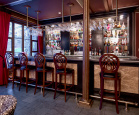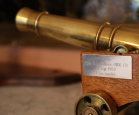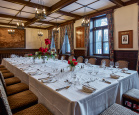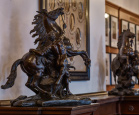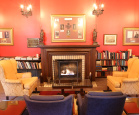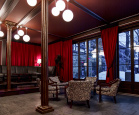The history of the Garrison Club
Since its inception, the Garrison Club has occupied the current building, located at 97 Saint. Louis Street. The oldest part of the building was constructed in 1816 to house the office of the supervisor of works as well as the draughting offices of the British Royal Engineers. In 1879, a few years after the departure of the British garrison from Quebec, the Club moved there and adapted it to the requirements of its members. The building subsequently underwent several renovations and, in 1893, the architect Harry Staveley installed the towers and castle style decor, very popular at the time and which characterizes the building today.
Initially reserved for military personnel, the Club started accepting civilian membership in 1891. During this era, it was restricted to men only but thanks to the national suffragette movement, women were admitted starting in 1918. However, they were not eligible to become full members until 1981, when the Garrison Club merged with the Cercle Universitaire and was renamed in french “Le Cercle de la Garnison de Québec”.
The Garrison Club offers its members many services of the highest standard.
This level of excellence is reflected in the stature of its guests who were welcomed throughout its history. Charles Lindbergh, Winston Churchill, Marshal Ferdinand Foch and the Prince of Wales (the future George V) are just a few examples.
Today, members and their guests from business, political, institutional, academic and cultural sectors meet there in a discreet and historic environment.
In 1999, The Garrison Club was designated as a national historic site of Canada.
The reasons for the designation were:founded in 1879 by officers of the tradition stemming from the British colonial period of assembling military officers in a suitable place for socializing
the Club has a strong and lasting symbolic value to Canadians who have achieved a high social and economic status
the Club, by its prestige, buildings and landscaped grounds, enriches the heritage character of Old Quebec
the Club is an integral part of the fortifications of Quebec.
THE FIRST PRESIDENT OF THE GARRISON CLUB:
LIEUTENANT-COLONEL JUCHEREAU DUCHESNAY
By Jean-Marie Lebel, historian.
In the streets of Old Quebec, where he lived, the first president of the Garrison Club did not pass unnoticed and for good reason. Lieutenant-Colonel Henri-Théodore Juchereau Duchesnay, who presided over the Club from 1879, was a colossus of not less than six and a half feet. Obviously he was a giant in his time. Born in Quebec in 1836, he was a member of the old nobility who had come from France in the days of Samuel de Champlain. He was descended from several seigneurial families from Beauport and Cap Rouge. By chance, the same time the Lieutenant-Colonel became president of the Garrison Club, the old family mansion in Beauport was engulfed in flames.
The selection of Juchereau Duchesnay as president of the Garrison Club was a virtual certainty, the reason being that, when the British garrison with its many officers, withdrew from Quebec in 1871, to return to England, it had left only a small contingent of local Canadian militia to defend the old city. Of these, Juchereau Duchesnay, by his stature and responsibilities had become the most prominent military person in Quebec. He had gained experience in the British regiments and had served in Gibraltar, and as Commander of the 7th Military District of Canada, whose headquarters were in Quebec.
For years, people saw him walking from his residence on Mont-Carmel Street to the Garrison Club, already housed in its present premises. He was president in 1882 when he married his second wife, Emma Caroline Tessier, who had grown up on Saint-Louis Street, daughter of Quebec mayor, Ulric-Joseph Tessier. Juchereau Duchesnay continued to preside over the Garrison Club for 18 years until his retirement from the military. The journalist Leon Ledieu has remarked, " With duty as his constant guide, if Lieutenant-Colonel Juchereau Duchesnay could arrive at one of the finest military positions in the country, he acquired even greater esteem from his fellow citizens."
His portrait may be seen in the Presidents’ room of the Garrison Club.
